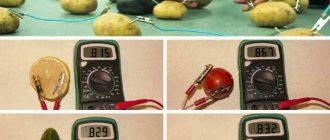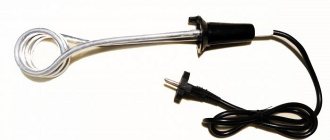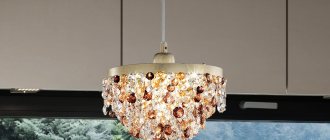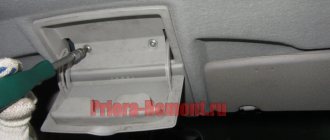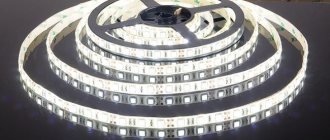Are you dreaming of adding brightness to the nursery or refreshing your workspace in the house? Or maybe you are a lover of the East, where the fashion for these such delicate little things came to us from? Then you should definitely read how to make a lamp out of paper with your own hands - unusual, original little things will instantly add a bit of magic to any corner of the house!
We guarantee that your guests will be asking for a long time where you bought this designer lamp, and having learned that you made it yourself, they will ask you to tell you how to make a paper chandelier with your own hands and its step-by-step instructions.
In this master class we will show you four ways to make a lamp out of paper, look and choose the option that’s right for you.
Master class No. 1: Chandelier “Coral inspiration”
To create this delicate lamp, prepare:
- Colored paper of any color;
- PVA glue or glue stick;
- Paper clips;
- Compass;
- Scissors;
- Fishing line;
- Colored yarn;
- LED lamp (never an incandescent lamp);
- Wire with switch.
Step-by-step instruction:
Step 1
- Using a compass, draw semicircles 1 cm wide on a colored sheet of paper.
- With each line we increase the diameter of the semicircle.
- Please note that you will need quite a lot of sheets. Then cut out semicircular strips and cut them into pieces of 2-5 cm.
Step 2
- Roll and glue the resulting strips, making one side larger than the other - this will make it easy to glue them together into a dome-shaped shape. After that, you can connect them with glue in pieces of five.
- Glue the clusters together, strengthening them with paper clips until the glue dries. Glue until you have a circle with a small hole for the lamp.
Of course, you can fantasize, and your lamp will be a little different than ours.
Step 3
Now, while our glue is finally drying, let's decorate our wire. To do this, take yarn of any color you like and carefully begin to rewind the wire with it. Try not to leave any uneven spots when wrapping the yarn over the previous layer.
You can add a drop of glue to the end of the yarn to strengthen it.
Step 4
Let's make a holder for an LED lamp. To do this, we tie a fishing line on three sides (it is advisable to measure the distance evenly) to our glued strips, and the other ends to a paper clip, which we first straighten to the shape of a triangle.
All! All that remains is to place the lamp in the circle and screw it to the wire. You can hang such a lamp either separately or in combination with, for example, an unusually shaped branch.
Lamp in the shape of a wreath
To make such an original lamp, you will need thick and thin wire, paint, lace paper coasters and the garland itself.
Step 1. Cut the thick wire into pieces of different lengths and roll each into a ring. We connect the ends by welding or tying them with soft thin wire. We connect the rings to each other with several jumpers.
Step 2. To prevent raw metal from showing through the decor, paint the resulting frame with white paint.
Step 3. We evenly braid the rings with a garland with small elongated bulbs. To prevent it from moving, we grab the wires here and there with thread or tape. We put paper decor on each light bulb, carefully piercing it in the center.
Step 4. Hang the wreath on the wall next to the outlet and plug it in.
You can decorate such a lamp with other available materials: tinsel, artificial flowers, bows, large beads, etc.
Master class No. 2: Chandelier made of rice or parchment paper
We present to your attention a new master class in which we will teach you how to make lamps from rice paper. There is nothing complicated in making it, as it might seem at first glance, and you can involve all household members in this exciting activity. The designer lamp is suitable for both the nursery and your bedroom.
Instead of rice paper, you can buy a roll of parchment paper for baking
So, to make a lamp you will need:
- Unnecessary lampshade;
- Thin wire;
- Several rolls of rice paper;
- Iron;
- Paper cutter;
- Sewing machine.
Self-production
Step 1
Take a lampshade you don’t need (you can buy an inexpensive new one ) and remove everything from it, leaving only the base. If your lampshade is similar to ours, then add a wire in the middle, securing it well.
Step 2
- Prepare the parchment paper by unrolling the rolls and cutting them into roughly equal rectangles.
- Iron the sheets until they are completely even and smooth.
- Fold each sheet like an accordion, measuring equal distances of strips, and use a paper cutter to cut equal, even circles.
- Try to use the cutter more carefully and not leave a lot of excess paper - you will need a lot of circles.
Step 3
- Connect all the circles together by stitching in the middle. Make connected circles of equal length and begin to strengthen them around the circle of the lampshade.
- Once you complete the first circle, go around the subsequent ones, decreasing the length each time.
- Carefully secure your lamp in the desired location, straightening all the threads.
Remember to use only LED lamps to avoid fire.
This beautiful chandelier is the result of painstaking work, after completion of which you will admire your work and be proud of yourself for a long time. On our website you will find many more ways to diversify your home lighting, for example:
- You can make chandeliers from bottles or plastic bottles.
- Chandeliers made of pipes in the loft style, for lovers of modernism.
- Or wooden chandeliers for eco-style lovers.
You can also, at your discretion, paint the rice paper circles in any shade , based on the color scheme of the room. If you want to hang this lamp in a child's room, you can add, for example, glass angels on long gold threads - again, choose the right accessories for different rooms, this will add warmth and originality.
WARNING: Be aware that incandescent lamps produce very hot temperatures and may cause paper to ignite. For paper lamps and fixtures, use only LED lamps.
Lightweight and elegant cardboard lampshade
For a paper lampshade, paper or thin cardboard is suitable. Such a lampshade can be either rectangular or square. First you need to think about the size of the lampshade; the larger the room, the wider the structure can be.
In a small nursery or hallway, a lampshade with a diameter of 30–35 centimeters will look good.
The frame can be made of wire; it will consist of an upper and lower part; consider making a lampshade in the shape of a cylinder.
- You need to make two circles of wire of the required diameter. They are connected to each other using a fishing line, the distance between the lower and upper frames is 12 - 15 cm, the hoops are fastened with fishing line in three or four places. The larger the diameter of the base, the more connecting elements need to be made.
- On a piece of paper you can draw circles of different diameters and figures of cartoon characters. Outline drawings can be taken from the Internet and printed, then redrawn using carbon paper.
- A special ruler is suitable for drawing circles, or you can outline lids or buttons of different diameters. Some designs are cut out completely with a stationery knife, others are cut along the contour.
- The paper is tried on the base and glued with an overlap. Then glued to the wire; it can also be secured with thin wire.
- To do this, first make a hole in the paper with a thick needle or awl, then thread the wire and carefully tie it to the frame. It is advisable to glue thin paper, as it can easily be damaged.
Master class No. 3: Origami chandelier made of paper
This beautiful bright lamp really resembles a ripe berry!
To make it, take the following:
- 2 paper bags, so that when gluing you get a one and a half meter bag (preferably with an interesting print);
- LED lamp (never an incandescent lamp);
- Wire with switch;
Step 1
We advise you to first practice folding origami. We have provided you with a diagram for correct folding - you can change the dimensions as you wish.
As soon as you decide that training is no longer necessary, we begin preparing the paper bag. Remove the handles and cut the bottoms off the bags and glue them together to make one large paper bag.
Step 2
Fold the resulting bag in half, and then fold the halves like an accordion so that you get 16 identical folded strips. Then fold the two outer strips diagonally.
Follow the simple diagrams and you will get wonderful lamps to decorate your home. You may have to practice a little to fold origami perfectly, but you won’t regret it, because origami is a whole world of various interesting things created with your own hands. And your children will simply be amazed by your skillful hands!
Materials and tools
You will need:
- Basic set for pajak (you can purchase a ready-made set or all elements separately): hoop bar,
- paper straws,
- balls with holes,
- steel clamps,
- cord with brass ring,
- base cords.
You can use your imagination and replace elements depending on what is available.
Master class No. 4: Corrugated paper lamp
To make an unusual lamp you will need:
- Corrugated paper 88×44cm;
- Ruler;
- Spoke;
- Glue;
- A thread;
- Cable;
- LED lamp (never an incandescent lamp).
Step 1
- Using a ruler, mark a sheet of paper at equal intervals and fold it like an accordion along the markings .
- Helping yourself with a knitting needle, fold the folded sheet of paper diagonally, first on one side, and then unfold it on the other side.
- Unfold the sheet - you should have a double sheet marked with diamonds .
Step 2
- Connect the marked lines according to the photograph; it is advisable that the sheet is not very wrinkled at this time - otherwise the appearance of the lamp will be spoiled.
- All that remains is to connect the top of the lamp with a thread so that it does not fall apart, and secure the cable with the LED lamp.
Be safe - do not use regular incandescent lamps, they heat up the paper and it may catch fire.
How to make a bottle base
An interesting option for mounting a lamp is a glass bottle. Holes are drilled at the bottom and in the lid using a drill. Connect to a metal support placed horizontally using nuts and washers.
The electrical cord is threaded through the holes and brought to the neck of the bottle, connecting to the cartridge.
The completed lampshade and cartridge are securely fixed at the top of the bottle neck. Glass can be painted or decorated using jute filigree technique.
There is another option. If the neck of the bottle is wide and the cartridge fits into it, then the wire is taken out through it and without the labor-intensive operations of drilling glass.
Paper butterfly chandeliers
The most popular paper chandelier is the butterfly chandelier. And such love for this product is not just:
- firstly, it looks very chic and expensive.
- And secondly, the production is very simple, even a child can be involved.
Such an elegant lamp will go well with any interior style, and it is also appropriate in the living room or dining room and even in a children's room.
Manufacturing technique:
- The basis is an old chandelier or its frame. If this is not the case, then you can take a regular metal or wooden rim. If there is no such thing, take a thick wire and make 2-3 coils of yourself, so that you get a circle.
- Cut out butterflies according to the template (butterfly template below)
- We take a nylon thread or fishing line and attach butterflies to it. There can be two types of fastenings: either we pierce the butterflies or we put them on silicone glue. Whichever is more convenient for someone.
Butterfly pattern
To make a chandelier with butterflies, just take a template and scale it to your size. It looks very nice if you make butterflies of several sizes, for example 3-4 diameters. Using a pencil, draw the sketch on paper and cut it out.
- It is best to cut with a stationery knife
or straight nail scissors without curves. - It is better to use paper that is thicker and that does not attract dust , for example, a velvet structure. Since you will have to vacuum such a chandelier often
It is also a very beautiful option if you make a ball out of wire, take an old pendant from a chandelier as a basis and place several butterflies using a glue gun.
Table lamp
If you don’t have any handmade skills, you should practice creating simple lamps from corrugated cardboard. They are perfect for the interior of a bedroom, kitchen, hallway and do not require any special knowledge in needlework.
To work you need to prepare in advance:
- corrugated cardboard;
- ruler and pencil;
- glue “Moment Joiner” or any other reliable composition;
- stationery knife;
- ready-made plastic base for a light bulb with socket.
Cardboard consumption will depend on the planned size of the lamp. On average, one package of large household appliances or several ordinary boxes are used. As for glue, it is better to buy a non-toxic, odorless composition that can be used indoors.
Lamp manufacturing procedure
At the first stage, a solid base for the lamp is made. To do this, cut out a square of cardboard with a side of 25x25 cm (or any other size, depending on your needs).
Find the center of this square by connecting lines passing through the midpoints of the sides. Mark the central point with a cross, on which the ring from the lamp socket is placed. The ring is outlined with a pencil, a circle is obtained for convenient alignment of the lampshade with the base. This circle is cut out with a stationery knife.
Next, four identical squares are drawn and cut out on the workpiece. Between them and the central circle, as well as between the edges, there should be gaps of sufficient thickness. Due to the presence of voids, light will penetrate well through the cardboard walls.
The blank with the slots is tried on the base of the lamp - it should fit tightly and not wobble. At the next stage, rectangular parts for the lampshade are made. Their length is 25 cm, and their width is 3-4 cm. Their number can be arbitrary, but quite large.
The lampshade is assembled as follows:
- Lubricate two strips with glue and stick them on two opposite sides of the base.
- The next pair of strips are glued to the free edges of the square directly on top of the first elements.
- Repeat the manipulations. This way they make a lampshade of the required height.
- A socket and a light bulb are inserted into the center of the finished lamp and secured securely with glue.
- The cardboard lamp is ready.
Corrugated table lamp
Advice! It is better to use it together with an energy-saving light bulb that does not get very hot in order to comply with safety precautions.
Paper ball chandelier
The basis for such chandeliers is a ready-made Chinese lamp made from a ball of rice paper. They are usually very cheap, down to 1-2 dollars. But you can decorate it however you like with paper tartlets, an unnecessary map, newspaper or sheets of old books. We are publishing several ideas for decorating a ball chandelier with paper.
How to make a lamp with your own hands in Oriental, Japanese, Chinese style?
Lamps play an important role in the design of premises. A lamp successfully chosen in style and color can transform an ordinary room interior into a stylish and modern one.
There are many options for lamps: wall, pendant, floor, table.
Let's talk about table lamps. They can be used in various rooms: in offices, bedrooms, living rooms. You can make a table lamp yourself.
With some effort, you can invent an original designer lamp. This way you will emphasize the uniqueness of your interior.
First you need to decide on the style of your lamp. Oriental style is popular. Let's consider what features a Japanese-style lamp should have:
- Simplicity
- Strict geometry
- Convenience
- No acid colors
Japanese lamps are usually rectangular in shape. Sometimes you can find round-shaped lamps. In Japanese style, table lamps are rarely used; soft light should come from them.
The color range is not rich: black, white, brown.
The decor of the lamp may include the following elements:
- Japanese or Chinese characters
- Applications
- Painting in Chinese or Japanese style.
Important: An oriental-style lamp will fit perfectly into the interior of a room that is also decorated in this style. When choosing the style of your future lamp, be sure to consider the overall style of your room.
To make a lamp in an oriental style you will need the following tools and equipment:
- Base with an old lamp socket
- Wood slats
- Rice paper, tracing paper or plywood
- Wood glue
- Saw
- Square
- Scissors
- Brush
- Paints
Step-by-step production:
- The first step is to make blanks from wooden slats. Using a saw and square, prepare 4 long slats and 8 short ones. Select the size yourself, based on the size of the room, the size of the table or bedside table on which the lamp will stand.
- Sand all the slats with sandpaper to avoid any roughness or nicks.
- Next, you need to glue all the parts together and let them dry. Assembled nails of this design should not be used. You can fasten the slats with rope.
- Paint the lamp frame black, white or brown. Let the paint dry. You can open the structure with varnish.
- After this, cut out 4 layers of the required size from rice paper or tracing paper. For this you can also use plywood, which will be more durable and practical.
- Apply the drawing with paints. You can cut out an ornament on paper by first printing the finished design on a printer.
- If you took plywood, then first print the drawing on paper and then transfer it with a pencil onto the plywood. Cut out the picture on plywood.
- Glue paper or sheets of plywood between the frame frames with glue.
- Place the frame on the base of the old lamp with socket.
Important: For such a lamp, choose an LED or “housekeeper” bulb.
Paper New Year lamp
A regular idea for the New Year is to use an old lampshade and string snowflakes of various shapes onto a string. Very impressive and beautiful. Below are some photo ideas for such decor for the New Year.
To hone your skills, as well as add to your collection of extraordinarily beautiful lamps, check out more ideas and master classes on table lamps using improvised materials . We are sure that among them you will find many that you will definitely want to create!
Old-new and miscellaneous-other
I propose to get rid of the trash by creating a lamp with your own hands from scrap materials. The already mentioned old Soviet chandeliers provide the greatest scope for imagination. Or rather, the frames are from them. You just need to figure out what to replace the pendants with.
Options:
- Wine bottle caps on laces or chains.
This chandelier will make you a lover of good wine.
- All kinds of fishing gear - floats, spoons.
A fisherman will see a fisherman from afar
- Scraps of colored fabric or ribbons.
And everyone will understand that a dressmaker lives here
- Beads strung on a fishing line, flowers, butterflies, birds and any other figures cut out of cardboard or thin plastic.
Several of these beads will add a special chic to the chandelier.
It is advisable to first paint the frame and wrap it with thread or fabric so that nothing reminds you of the old chandelier. And if you don't have one, you can easily make one from thick steel wire. This is even more interesting, since it can be given any shape except round.
I also liked the idea of making my own lamps from old umbrellas. Their hollow handles are perfect for hiding electrical wires.
Just an umbrella
And here the fabric has been removed from the frame, and it itself is wrapped in an LED garland. Very gentle and unusual
If you have a daughter for whom elegant skirts and dresses have become too small, you can dress up an old shabby lampshade in them. And change outfits at least every day.
Lampshade made from a tutu
Nice job: washed, ironed and put it back in place. And there is no need to jump on a stepladder with a basin and a rag.
Shabby chic chandelier
To create spectacular lighting in a room, you can also make a chandelier from fabric or beads. The result will be a kind of candelabra or lampshade in the “shabby chic” style.
Materials:
- a ready-made metal or wooden frame (or it can be made from an old hoop, garden basket, thick wire);
- socket and lamp;
- chains and threads for decoration;
- all kinds of beads and seed beads.
Working on such a lampshade is not difficult, but it is a very painstaking task. Such chandeliers usually consist of two or three levels of rings, which are located on top of each other. It all depends on the size of the chosen bases. If you take rings of the same diameter, the finished product will be made in the “modern” style.
One of the important points is that before you start decorating the chandelier, you need to paint and wrap the frames with decorative materials!
The approximate consumption of beads is:
- For the lower part of the lampshade - 16 mm beads, about 15-17 pieces per thread;
- For the upper part of the lampshade - 12 mm beads, about 35 pieces per thread.
Naturally, when stringing beads on a thread, you can increase or decrease their number or the degree of thread tension. But it is still advisable to stock up on materials in excess of the norm.
The essence of the work is to hang threads with beads in a “waterfall” or “cascade” so that they flow downward along the structure.
In order to create the effect of “muting” the light, you can sheathe the frame with thick fabric.
A DIY chandelier will definitely add a fresh touch, originality and beauty to your interior. You will immediately notice how the room will sparkle with new colors, and your guests will sincerely admire your creativity, hard work and original taste!
Original lampshade made of paper tubes
This lampshade can be used to decorate a floor lamp or table lamp. It looks unusual, gives a soft, subdued light and will become an interesting highlight in any modern interior. To make it, you need to roll about 100 pieces of newspaper. thin tubes (the exact number depends on the desired shape and size of the lamp) and secure their edges with glue.
You can leave the blanks multi-colored or with a black and white newspaper print to add a touch of outrageousness to the design. But if you are a fan of classic things, wrap each tube in white or any plain paper. This way the product will look whole and organic.
You can take any polygon as the basis for such a lamp. In our case, this is a pentagon. In its form we lay out the bottom row, fastening the tubes together with PVA glue.
Next, we line up the walls so that the lampshade expands in the center, increasing the diameter of the shape, and gradually decreases towards the top until it is completely closed, giving the finished product a spherical appearance.


